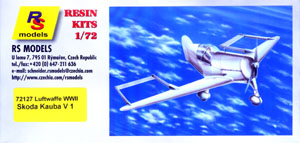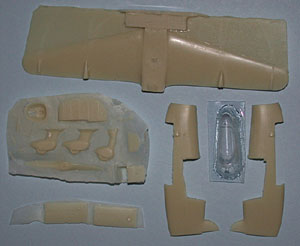RS Models 1/72
Skoda-Kauba V1 By Jim Schubert |  | History Boy, I was really at a loss on this one. The single A4 size sheet of information enclosed with this kit is all in Czech save for the specs and the colors. Trying to read Czech when your cradle-tongue is English, and the only other languages you've studied are Latin and Japanese, is wasted effort. A few words, names and dates come through but that's about all. I tried Robert Schneider's (That's where the "RS" comes from.) web site hoping to find some help but was thwarted because the text there that relates to this plane and its series sisters is also all in Czech. It's quite an interesting site; do take a look - it's linked later in this review. To bale us out our editor contacted his friend Peter Buchar, of Czech Master Resins, for help. Peter provided the background information upon which this "History" is based. In early 1942 Otto Kauba, an Austrian aeronautical engineer, took his concept of an unmanned flying bomb of unusual configuration to the Reichs Luftfahrt Ministerium (RLM - German Air Ministry). They liked his ideas and facilitated the setting up of the Skoda-Kauba design bureau in German occupied Prague. The designs of this bureau were to be produced by established airframe manufacturers. Of the many designs ultimately produced by the SK bureau, none ever achieved production status. At its peak SK employed about 120 people. The SK V1, V1a and V2 built to test Kauba's unconventional airframe configuration, were all propeller driven lightweight monoplanes with elevons on booms behind the wing. The engine was a Walter Minor inverted air-cooled four-cylinder in-line. Its Czech test pilot in an act of sabotage deliberately crashed the first plane. He escaped physically unharmed. Although I'm not an aeronautical engineer, I do have a fair understanding of the dynamics of flight and I can see no structural, control or stability advantages to this peculiar configuration. Quite the contrary, in fact. Although schemes for powering the SK flying bomb with a pulse-jet were mooted, the whole project was abandoned at the end of 1943 because of the far greater promise shown by the more conventional Fiesler Fi.103 V1. I believe the "V1, V1a", etc. applied to the SKs were in the German fashion of assigning "Versuch" (test or experimental) numbers to prototypes, whereas the "V1" assigned to the Fi.103 was derived from the term "Vergeltungswaffen" (vengence weapon); the same is true for the "V2" applied to the later ballistic missile. SK's subsequent designs were along conventional lines. The V3, V4 and V5 led to the model SK257, which was a fighter transition trainer intended for use by the Luftwaffe. Four prototypes of the SK257 were built by Avia in their Prague facilities and tested there by the RLM. Satisfied with the results of the testing, the RLM ordered quantity production to begin at a factory in Trencin, Slovakia. In the event, only five were built. The quality was so bad (more sabotage?) that the whole lot was rejected and nothing more was ever heard of Skoda-Kauba.  Robert Schneider lists, and illustrates, kits for: V1, V1a, V2, V3 and V5 Skoda-Kaubas on his web site. Robert Schneider lists, and illustrates, kits for: V1, V1a, V2, V3 and V5 Skoda-Kaubas on his web site.
The Kit This is a little fellow! The wingspan is only 3 and 5/8 inches and the length is 2 and 5/16 inches. This is the first Robert Schneider kit that I have seen and it looks very good indeed. There are 18 well cast resin parts and none of them has any discernible flaws. The few scribed panel lines on the aluminum skinned fuselage are, however, rather faint and should be enhanced a bit. There are no panel lines on the wing as it was covered with light plywood, which was - in turn - covered with fabric and heavily doped. A few of the 18 parts are best replaced with items made of metal wire: the control stick, the pitot tube, the tail skid and the wire fuel quantity indicator (just like the ones on vintage Cubs). Only one very clear vac-formed windscreen/canopy is provided. Interestingly, the instructions tell you to make the tail booms from scratch. (?) All of this is packed in a nice top-opening box that is stout enough for its intended use. Instructions are almost non-existent. In addition to the history, specs and color notes the information sheet contains a poorly reproduced side view photo, a three-view general arrangement drawing and the maker's web site and e-mail addresses; that's all. There is no decal sheet because the plane had no markings; not even a civil registration. Conclusion I like it. It's another kit of a delightful oddball airplane from our Czech friends. Congratulations to Robert Schneider for being so imaginative and for doing such a high quality job. The only thing needed to make the kit better, for me, would be an English translation of the history. You can order kits direct from Robert, using a credit card, via his web site (www.rsmodels.cz). I have no idea what the prices are, as none are given. Congratulations to Robert for using a good stout top-opening box. References Beyond the kit's instructions and the rather nice box art, all that I could find was a review of the V1 kit by Ernie Lee in the Vol. 23, No. 1, March 2001 issue of Scale Aircraft Modelling magazine. Thank goodness Peter Buchar came to the rescue. | 

 



|
